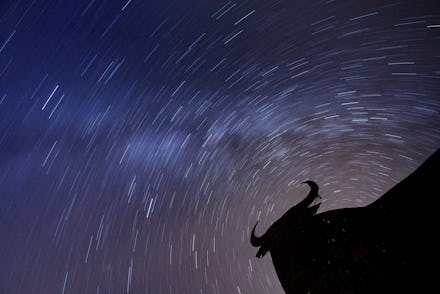Here are the dates of every major meteor shower in 2017

We're just four days into 2017 and the new year has already given us a glimpse at a spectacular meteor shower. The Quadrantid meteor shower peaked on the night of Jan. 3 to Jan. 4 due to the debris tail from asteroid 2003 EH1.
Meteor showers occur when space rocks enter the Earth's atmosphere, and as they fall toward the planet, the resistance of the air makes the rocks, known as "meteoroids," extremely hot. What we see in the sky is the glowing hot air mass as the rock travels across the atmosphere. When several meteoroids run into our planet at once, it is called a meteor shower.
If you're thinking about hosting a late-night stargazing party, here are some dates to consider.
Quadrantids: Jan. 1 to Jan. 10
According to the American Meteor Society, these meteors have the potential to become one of the most spectacular showers of the year, though it can fall short because of fickle January weather conditions and its relatively brief six-hour period of peak activity. Its peak night occurs Jan. 3 to Jan. 4.
Lyrids: April 16 to April 25
The AMS says Lyrid is a medium-strength shower that can be seen from the Northern Hemisphere at dawn, as well as from the Southern Hemisphere — albeit at a lower rate. Its peak night takes place on April 21 to April 22.
Eta Aquariids: April 19 to May 26
The Eta Aquariid shower is stronger if seen from the southern tropics. Its peak night occurs on May 6 to May 7, according to Basic Astronomy.
Alpha Capricornids: July 11 to Aug. 10
This shower is not too strong but, unlike many, it can be seen on either side of the equator, according to the AMS. Its peak night takes place July 26 to July 27.
Delta Aquariids: July 21 to Aug. 23
The Delta Aquariid has a stronger presence in the southern tropics, but its meteoroids lack persistent trains and fireballs. Its peak night occurs Jul. 29 to July 30, according to the AMS.
Perseids: July 13 to Aug. 26
Among stargazers in the U.S., Perseid is one of the most popular meteor showers, as it peaks on August nights and can be seen from the Northern Hemisphere. According to Basic Astronomy, its peak night takes place on Aug. 12-13.
Orionids: Oct. 4 to Nov. 14
The Orionids create a medium-strength shower that sometimes reaches higher activity like Perseid. The shower's peak night is Oct. 21 to Oct. 22, according to Basic Astronomy.
Southern Taurids: Sept. 7 to Nov. 19
The falling Southern Taurids result in a long-lasting shower but one produces just more than five shower members per hour, a relatively low number. Its peak night takes place on Oct. 9 to Oct. 10, according to the AMS.
Northern Taurids: Oct. 19 to Dec. 10
Like the Southern Taurids, Northern Taurids occur over a span of two months. When these two showers become simultaneously active in late October, it creates increased fireball activity. Peak night occurs on Nov. 10 to Nov. 11, according to the AMS.
Leonids: Nov. 5 to Nov. 30
Leonids are known for causing large meteor storms, with some of the most notable occurring in the mid-1800s, in 1996 and again in 2001. Its peak night occurs Nov. 17 to Nov. 18, Basic Astronomy reported.
Geminids: Dec. 4 to Dec. 16
Germanids are usually the strongest meteor shower of the year, and it can also be seen from the Southern Hemisphere. According to Basic Astronomy, Germanids' peak night takes place Dec. 13 to Dec. 14.
Ursids: Dec. 17 to Dec. 23
The AMS underscores that this shower, which occurs just before Christmas, is strictly a Northern Hemisphere stargazing show. Its peak night takes place Dec. 22 to Dec. 23, according to Basic Astronomy.